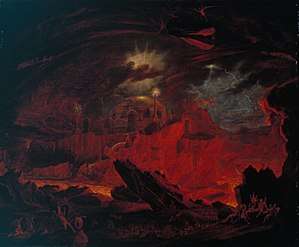Asphodel Meadows
The Asphodel Meadows is a section of the ancient Greek underworld where ordinary souls were sent to live after death.
| Greek underworld |
|---|
| Residents |
| Geography |
| Famous Tartarus inmates |
| Visitors |
Origin
The Oxford English Dictionary gives Homer as the source for the English poetic tradition of describing the meadows of the afterlife as being covered in asphodel. Homer's "asphodel meadow" (ἀσφοδελὸν λειμῶνα), "where the spirits of the dead dwell" (Od. 24.14), has throughout Western literary history been envisioned as a pleasant and even desirable place. This was the impression among many of the ancient Greek poets and Homeric commentators, who understood the adjective ἀσφοδελός to mean "flowery," "fragrant," "fertile," and “lush,” and who even referred to the asphodel meadow as a “paradise” (παράδεισος). This was all the more so among the post-Renaissance English poets, especially those of the Romantic tradition, who painted colorful pictures of “happy souls who dwell in yellow meads of asphodel.” But this is not the picture drawn in books 11 and 24 of the Odyssey, our earliest extended descriptions of Hades, and our earliest references to an “asphodel meadow.” The three Odyssean passages in which Hades features an “asphodel meadow” (11.539, 573; 24.13) portray a dark, gloomy, and mirthless place.
This is not the Elysian Plain, where life is easy, and there ever blows a refreshing West wind (Od. 4.561-69); nor is it the Isles of the Blessed, where the grain-giving soil bears its sweet fruit for the most distinguished, and carefree, heroes (Hesiod’s Op. 167-73); this is Hades – dark, dank, and sunless (Od. 10.512; 24.10; cf. Il. 20.65; H.Dem. 337) – where disembodied and senseless spirits of the dead weep and wail pathetically (Od. 11.391, 475-6, 605-6; 24.5-9) and flit about purposelessly like shadows or dreams (Od. 10.495; 11.207-8, 222). The disjunction has caused Classical scholar and linguist Steve Reece to propose a period in the development of the epic diction when the shape of the formula used to describe Hades was κατὰ σποδελὸν λειμῶνα “throughout the ash-filled meadow." This formula, Reece proposes, was misheard, misunderstood, and misanalyzed by a pre-Homeric bard as κατ’ ἀσφοδελὸν λειμῶνα “throughout the asphodel (i.e. flowery) meadow.”[1]
Later depictions
The Asphodel Meadows is most probably where the souls of people who lived mediocre lives remain, but its relationship to other places in the Greek afterlife remains uncertain.
For later Greek poets the very ancient pre-Homeric association of the Asphodel flower with a positive form of afterlife as well as the enlarged role of Elysium as it became the destination of more than just a few lucky heroes, altered the character of the meadows. Greek poets who wrote after Homer's time describe them as untouched, lovely, soft and holy. Such an evolutionary change is quite common: "Like most cultures throughout human history, both ancient and modern, the Greeks held complex and sometimes contradictory views about the afterlife".[2]
Some depictions describe it as a land of utter neutrality. That is, while the inhabitants were in life neither good nor evil, so they are treated in the afterlife. Other depictions have also stated that all residents drink from the river Lethe before entering the fields, thus losing their identities. This somewhat negative outlook on the afterlife for those who make little impact was perhaps passed down to encourage militarism in Greek cultures as opposed to inaction. In fact, those who did take up arms and became heroes were rewarded with everlasting joy in the fields of Elysium.
Edith Hamilton suggests that the Asphodel of these fields are not exactly like the Asphodel of our world but are "presumably strange, pallid, ghostly flowers."[3] Others suggest that they were actually narcissi.[4]
References
- Reece, Steve, "Homer's Asphodel Meadow," Greek, Roman, and Byzantine Studies 47 (2007) 389-400.
- Reece, Steve, "Homer's Asphodel Meadow," Greek, Roman, and Byzantine Studies 47 (2007) 389-400.
- Edith Hamilton. Mythology. New York: Warner Books, 1999. Ch. 1, p. 40.
- Dweck, A. C. The folklore of Narcissus (PDF). pp. 19–29. In Hanks (2002)
Bibliography
- Hanks, Gordon R (2002). Narcissus and Daffodil: The Genus Narcissus. London: Taylor and Francis. ISBN 0415273447. Retrieved 2 October 2014.CS1 maint: ref=harv (link)
- Anonymous (May–October 1887). "Homer the botanist". Macmillan's Magazine. London: Macmillan and Company. 56: 428–436. Retrieved 3 November 2014.

